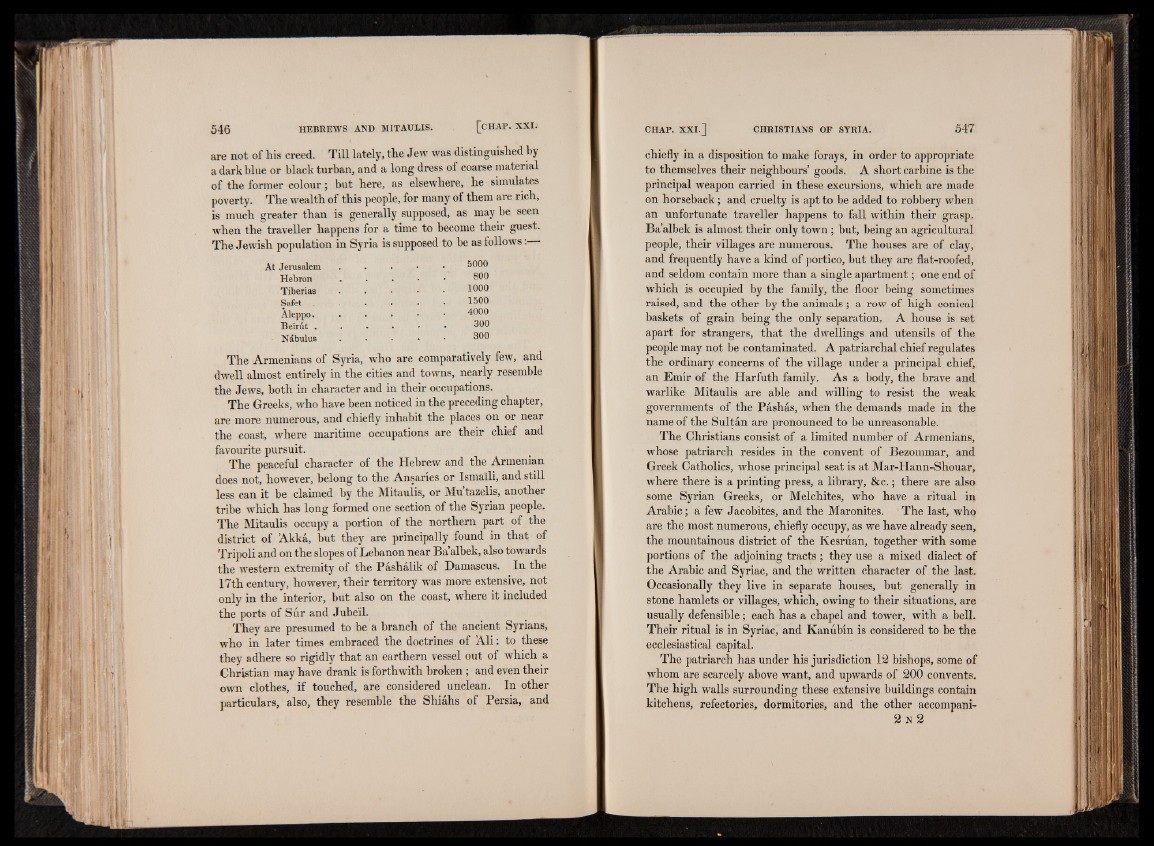
are not of his creed. Till lately, the Jew was distinguished by
a dark blue or black turban, and a long dress of coarse material
of the former colour; but here, as elsewhere, he simulates
poverty. The wealth of this people, for many of them are rich,
is much greater than is generally supposed, as may be seen
when the traveller happens for a time to become their guest.
The Jewish population in Syria is supposed to be as follows:—
At Jerusalem . . • • • 5000
Hebron . . . . . 800
Tiberias . . . . . 1000
Safet . . . . . . 1500
Aleppo. . . . . . 4000
B e irit . . . . . . 300
- Nabulus . 300
The Armenians of Syria, who are comparatively few, and
dwell almost entirely in the cities and towns, nearly resemble
the Jews, both in character and in their occupations.
The Greeks, who have been noticed in the preceding chapter,
are more numerous, and chiefly inhabit the places on or near
the coast, where maritime occupations are their chief and
favourite pursuit.
The peaceful character of the Hebrew and the Armenian
does not, however, belong to the Ansaries or Ismaili, and still
less can it be claimed by the Mitaulis, or Mu’tazelis, another
tribe which has long formed one section of the Syrian people.
The Mitaulis occupy a portion of the northern part of the
district of Akka, but they are principally found in that of
Tripoli and on the slopes of Lebanon near Ba’albek, also towards
the western extremity of the Pashalik of Damascus. In the
17th century, however, their territory was more extensive, not
only in the interior, but also on the coast, where it included
the ports of Sur and Jubeil.
They are presumed to be a branch of the ancient Syrians,
who in later times embraced the doctrines of Ali: to these
they adhere so rigidly that an earthern vessel out of which a
Christian may have drank is forthwith broken ; and even their
own clothes, if touched, are considered unclean. In other
particulars, also, they resemble the Shiahs of Persia, and
chiefly in a disposition to make forays, in order to appropriate
to themselves their neighbours’ goods. A short carbine is the
principal weapon carried in these excursions, which are made
on horseback; and cruelty is apt to be added to robbery when
an unfortunate traveller happens to fall within their grasp.
Ba’albek is almost their only town; but, being an agricultural
people, their villages are numerous. The houses are of clay,
and frequently have a kind of portico, but they are flat-roofed,
and seldom contain more than a single apartment; one end of
which is occupied by the family, the floor being sometimes
raised, and the other by the animals; a row of high conical
baskets of grain being the only separation. A house is set
apart for strangers, that the dwellings and utensils of the
people may not be contaminated. A patriarchal chief regulates
the ordinary concerns of the village under a principal chief,
an Emir of the Harfuth family. As a body, the brave and
warlike Mitaulis are able and willing to resist the weak
governments of the Pashas, when the demands made in the
name of the Sultan are pronounced to be unreasonable.
The Christians consist of a limited number of Armenians,
whose patriarch resides in the convent of Bezommar, and
Greek Catholics, whose principal seat is at Mar-Hann-Shouar,
where there is a printing press, a library, &c.; there are also
some Syrian Greeks, or Melchites, who have a ritual in
Arabic; a few Jacobites, and the Maronites. The last, who
are the most numerous, chiefly occupy, as we have already seen,
the mountainous district of the Kesruan, together with some
portions of the adjoining tracts ; they use a mixed dialect of
the Arabic and Syriac, and the written character of the last.
Occasionally they live in separate houses, but generally in
stone hamlets or villages, which, owing to their situation^, are
usually defensible; each has a chapel and tower, with a bell.
Their ritual is in Syriac, and Kanubin is considered to be the
ecclesiastical capital.
The patriarch has under his jurisdiction 12 bishops, some of
whom are scarcely above want, and upwards of 200 convents.
The high walls surrounding these extensive buildings contain
kitchens, refectories, dormitories, and the other accpmpani-
2 n 2